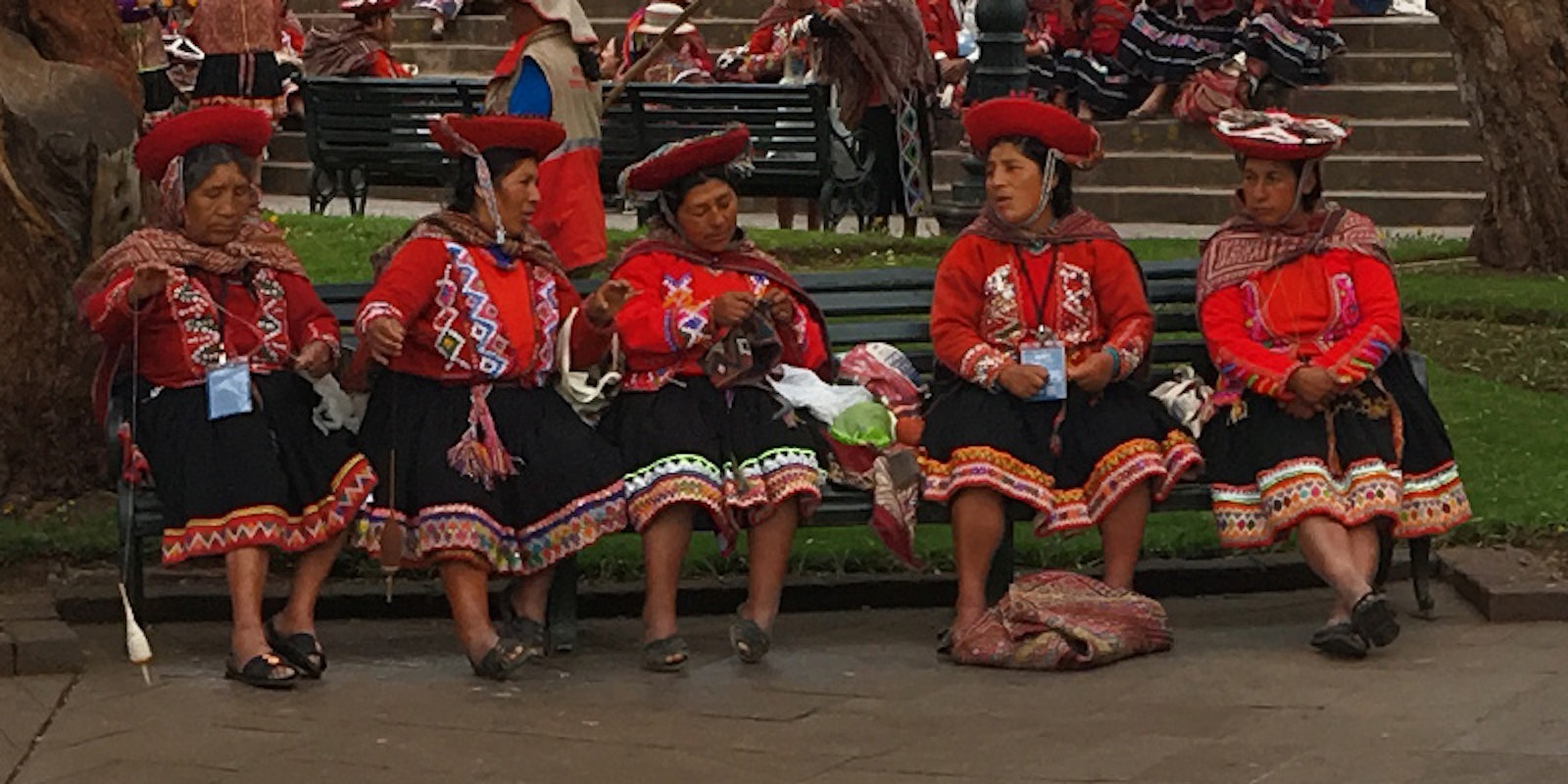In November 2017, hundreds of weavers gathered in Peru for the third Tinkuy. I count myself a spinner first, knitter second, and weaver third, so among hard-core weavers I might have been the odd woman out. But most of the weavers I met take drop spindle spinning for granted, the way that many of us take potable tap water for granted. Of course you spin. (In the Andes you do not take potable tap water for granted.)
I learned more (and bought more) in a week than I can tell you, but watching the Andean spinners, I realized 3 things that every spinner should know.
1. Everyone has time to spin.
Groups of weavers gathered in the plaza each morning before the conference, chatting with their neighbors before the doors opened. They wore an amazing variety of clothes: different hats from each village, distinct weaving patterns on each shawl, and a rainbow of color palettes. About half the weavers in each group—men and women—spun on drop spindles (called pushkas) as they waited. They had a few moments free; their spindles were ready.
If you reach for a drop spindle every time you’re standing and waiting, you will surprise yourself with how much you accomplish. Most of these weavers had cell phones tucked away in their skirts (and some had babies on their backs), but I didn’t see anyone staring at a screen while waiting. Ed Franquemont is often quoted saying that Andean spindle spinners are slower by the hour but faster by the week (from “Andean Spinning,” available in A Handspindle Treasury: Spinning Around the World). While I checked my email, these women were faster by the minute.
In the village of Amaru, a young woman spins as easily on a brand-new top-whorl spindle as her neighbor plies on a pushka.
2. Tools matter less than you may think.
Before the conference, I traveled with other spinners and weavers from the United States. In the market in Pisac, we found a booth selling some spindles along with spoons and bowl, each costing 10 soles (about $3). My spinning friends tested the spindles to see which were balanced and spun nicely; the local buyers gave the same scrutiny to the wooden spoons.
On the first night of Tinkuy, spinners competed to see who could make the longest thread in a few minutes, starting with a bare spindle. (Read Linda Ligon’s account of a past contest.) Each spinner picked a spindle and fiber at random from baskets passed around the room, and they spun like the wind. These spinners weren’t concerned about the perfect spindle weight or whorl diameter.
During the competition I made friends with spinners from Chinchero. I’d packed a few spindles, selecting ones that I thought would be novel to Andean spinners. Sure enough, the ladies of Chinchero met my top-whorl spindles with curiosity and amusement; they didn’t recognize my red-and-purple Trindle as a spindle at first. Within 5 minutes, though, each of the three spinners who tried it out made yarn successfully, some beautifully. (I managed not to embarrass myself with a pushka, too.)
The lesson: Use your beloved wheels and spindles, but remember that your hands are your most valuable tools.
In Amaru, the villagers shear part of a sheep with a kitchen knife; wash the raw wool in a detergent from a local root; and hand pick the fiber before spinning.
3. Fiber prep matters (but not like you think).
That night everyone got a drop spindle and a handful of possibly washed, somewhat teased alpaca fiber, which the Andean spinners double-drafted into smooth, fine yarn. I tugged at it and made some lumpy yarn, then soon switched back to the Merino/silk combed top I’d brought with me. I happily spun frog hair with a short draw on a pushka and my own lightweight spindle.
When I handed my Trindle and fiber around to try, the women laughed as they tried double-drafting the top. It was their turn to struggle with the fiber and make uneven yarn. After twenty minutes or so, the most persistent made perfect yarn, though she frayed and spun down the side of the top. It was easier for each of us to use new tools than unfamiliar fiber and prep.
Patabamba spinners tease handfuls of white wool and double draft.
Don’t be surprised if I mention Tinkuy in the next few months. There was a lifetime of spinning wisdom among those weavers.
—Anne Merrow
Learn Andean Drop Spindle Spinning Secrets!




